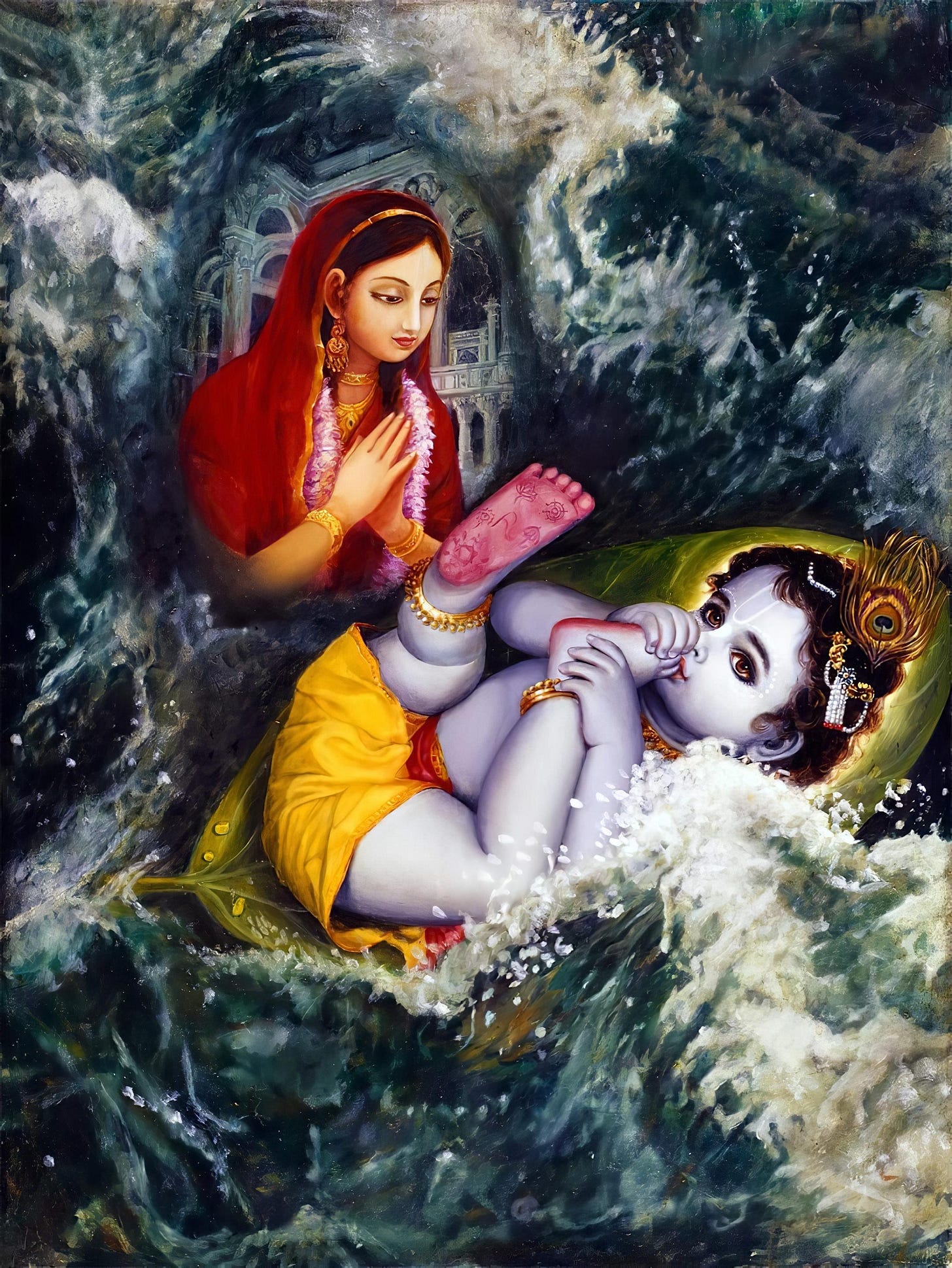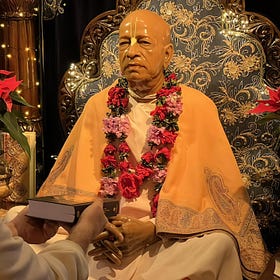The “fall” of the jīva and the eternal nature of the soul
From the spiritual perspective, of us as immovable souls, we never really left, although our consciousness became somehow entrapped here.
Our three immediate prominent ācāryas, Srila Prabhupada, Srila Bhaktisiddhānta Sarasvatī Thākura, and Srila Bhaktivinoda Thākura, share an agreement on the intrinsic nature of the soul as a servant of Krsna.
On CC Madhya-līlā 22.107, for example, Srila Prabhupada gives the following translation: “Pure love for Kṛṣṇa is eternally established in the hearts of the living entities. It is not something to be gained from another source. When the heart is purified by hearing and chanting, this love naturally awakens.”
Srila Bhaktivinoda Thākura named his main work “Jaiva Dharma”, which can be translated as “The Eternal Nature of the Soul”, again emphasizing the intrinsic nature of the soul as a servant of Krsna. When all material contaminations are peeled off, this natural love for Krsna automatically manifests.
However, we may have real trouble connecting our current consciousness with this perfect intrinsic consciousness. If my intrinsic inclination is to serve Krsna, how can my current consciousness be so far from it?
To understand this, it’s important to take into consideration that our current consciousness doesn’t have much to do with our original consciousness. Srila Prabhupada explains it by giving the analogy of a dream, which I believe is the best analogy that can be made on this connection.
When I’m inside a dream, I can’t remember who I really am, nor can I remember most facts from my “real” life. I also can’t think straight; everything just becomes hazy. Sometimes I may remember something from real life, or even understand I’m inside a dream, but even when this happens, I can still only think inside the constraints of the dream. It’s thus more about dreaming that I’m understanding that I’m dreaming than really being aware of it.
My sleep also has stages. There is very deep sleep, where there is practically no consciousness, different stages of lighter sleep, the dreaming stage where I perform so many activities in my alternated dreaming consciousness, and a transitional stage, where I’m almost awakened, but still sleepy and still under the effects of the dream. At this stage, my “real” consciousness is more or less awakened, but I still remember the dream and may easily go back to sleep and start dreaming again.
Similarly, our current consciousness is the product of the combination of the false ego, material mind, intelligence, senses, and finally the gross body, including the brain. All these different layers have different effects, and the final product is what we call consciousness. Similar to the limited consciousness we have inside of a dream, this is not really “us”, but just a temporary delirious stage. As difficult as it may seem from the position we are now, the goal of life is not to just remain in this dreaming condition, but to gradually peel the material layers and recover our original spiritual consciousness that is currently forgotten.
In the Bhagavad-gītā, Krsna explains that the soul is immovable. One meaning of that is that it is not possible to mechanically remove the soul from inside the heart and put it in a different place, as we can do with a material object. A deeper meaning, however, is that the soul is immovable because it never leaves its original position. Whatever the soul is, that’s what it is. There is no possibility of becoming anything else. This ethereal nature of the soul is defined by our ācāryas as a position of service to Krsna, whatever it may be. Losing this position would mean becoming something else, which is impossible since, by definition, spiritual things don’t change.
However, the soul may falsely identify with a temporary material consciousness, composed of false ego, mind, intelligence, etc. The soul thus doesn’t become something else, but identifies with it, just like someone playing a game on a computer doesn’t become part of it, although he may identify with the knight on the screen, thinking that he is killing orcs or being killed by them.
This material consciousness is different from the soul, and they don’t have any factual relationship (just like a human being and a computer), but we identify with it, just like a driver may temporarily identify with a car he is driving, or a gamer may identify with the avatar in the game he is playing and completely forget he has an existence separated from it. Different from the driver or the gamer, who can at any moment be easily pushed back to reality, our identification with the temporary material consciousness is much more intimate and long-lasting, and therefore much harder to give up. If one could play a game long enough, one would eventually forget his original identity as a human being and become completely absorbed in the game. His original identity would be thus “lost”, although in reality he is still a human being, and can go back to his original consciousness if he can somehow or other become free from the illusory reality of the game.
As in any example, this comparison of the conditioned soul and the gamer has its limitations, but still, the basic principle is similar, since it is based on a false identification. Following this example, we can understand why some of our ācāryas would use the word “lost” when describing the original position of the soul. When something is forgotten long enough, we can say that it is lost, and when something is “lost”, it implies we currently don’t have it with us, but it can still be recovered if we find it. Our true spiritual nature may be thus currently “lost” for us, and as a result, we are disconnected from our original consciousness of love to Krsna, but this original consciousness can be restored if we “find” it with the help of a self-realized soul.
This understanding is the key to deciphering many intricate philosophical concepts and apparent disagreements between different spiritual authorities.
In one sense, we were never out of this material world, because what we now call “us” (our current material consciousness, composed of the false ego, mind, intelligence, senses, etc.) is a product of this material world and was never outside of it. When we look from this perspective, we are eternally conditioned, and there was never a time we were out of it. We have for so long been disconnected from our eternal nature that it is practically lost to us.
In another sense, however, when we look from the spiritual perspective, of us as immovable souls, we never really left, although our consciousness became somehow entrapped here, identified with the temporary material consciousness. Going back to our original consciousness means thus coming to a stage of Krsna Consciousness, and in this purified consciousness abandon not just our current material body but also the subtle combination of mind, intelligence, and ego we have for so long identifying with. Although this process is extremely difficult, it is possible when we follow the process of Krsna Consciousness under the guidance of a pure devotee of Krsna.
This understanding allows us to reconcile many apparently contradictory ideas. The soul is an eternal servant of Krsna, but at the same time, we are here. We have an intrinsic propensity to serve Krsna, but at the same time, we may not have it now. Bhakti is eternally established in the heart, but at the same time, we depend on the mercy of the spiritual master to get it, and so on.
When we study the books of Srila Prabhupada, as well as those of our previous ācāryas, with the right understanding, we can understand that there are no contradictions between them. Because they try to describe such esoteric principles using mundane words (that are later adulterated by imperfect translations), there is a lot of space for misunderstanding. This leads to so many different opinions appearing, with people of imperfect intelligence trying to put one ācārya against the other.
In his Tattva Sandarbha, Srila Jīva Goswami explains that the Vedic literature is written in very esoteric language, and the only way to understand it is by receiving the right conclusions from a self-realized soul and studying the text under this prism. Even when we go to the works of our previous ācāryas, the possibility of misunderstanding is still present, since their books were written in a language and cultural context that is incomprehensible to us. We then come to the books of Srila Prabhupada, who is the current prominent link of our sampradāya. In these books, we finally find something that we can clearly understand, and if we accept all the conclusions he gives, we may be able to gradually study all the works of the previous ācāryas and understand them. Those who, on the other hand, reject his conclusions, arguing that he was just using “preaching strategies” or “giving only the ABCD”, risk becoming themselves locked out of the paramparā, and thus hopeless in their attempts to properly understand things.
You can also donate using Buy Me a Coffee, PayPal, Wise, Revolut, or bank transfers. There is a separate page with all the links. This helps me enormously to have time to write instead of doing other things to make a living. Thanks!
Read also:
A commentary on ‘Crow and Tal-Fruit Logic’ (Prabhupada's essay on the "fall" of the jīva)
At the beginning of our movement, disciples of Prabhupada had no doubts about our eternal relationship with Krsna and how the soul ends up in the material world, because the only source of information for them was the books of Srila Prabhupada, where the question is explained clearly. However, in the late 1970s, devotees entering in contact with other ideas transformed this point into a battleground. At some point, Prabhupada wrote an essay directly clarifying the topic to his disciple, Madhudvisa Prabhu, which I try to explain in detail here.




Thankyou prabhuji for writing this. 😊
Hare Krishna 🙏.